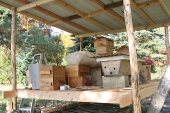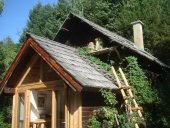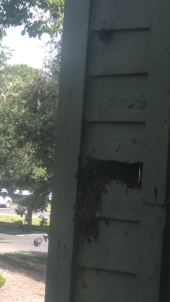
 28
28










 3
3




Moderator, Treatment Free Beekeepers group on Facebook.
https://www.facebook.com/groups/treatmentfreebeekeepers/





 4
4




 2
2




Miles Flansburg wrote:So I have a lower log where the queen lives, then each log above that has top bars to keep her out, is that correct?
I would only harvest the top log?
My project thread
Agriculture collects solar energy two-dimensionally; but silviculture collects it three dimensionally.




Zach Weiss wrote:This is what a finished nice one looks like, with a spiffy window for observation, and full of bees!
My project thread
Agriculture collects solar energy two-dimensionally; but silviculture collects it three dimensionally.

 6
6




Hans Albert Quistorff, LMT projects on permies Hans Massage Qberry Farm magnet therapy gmail hquistorff
 3
3




Moderator, Treatment Free Beekeepers group on Facebook.
https://www.facebook.com/groups/treatmentfreebeekeepers/





 12
12




Vic Johanson
"I must Create a System, or be enslaved by another Man's"--William Blake




Cj Verde wrote:This is how a Perone hive works. You only harvest the top log/super. The queen is too big to go above. You leave the bottom log where the queen is alone.
Those who hammer their swords into plows will plow for those who don't!
 4
4




 7
7








Theresa Brennan wrote:I am intrigued by the idea of leaving honey until spring to harvest as it seems to solve the problem of needing to feed sugar water if there is not enough honey left.
My project thread
Agriculture collects solar energy two-dimensionally; but silviculture collects it three dimensionally.
 3
3




Living in Anjou , France,
For the many not for the few
http://www.permies.com/t/80/31583/projects/Permie-Pennies-France#330873




Moderator, Treatment Free Beekeepers group on Facebook.
https://www.facebook.com/groups/treatmentfreebeekeepers/









David Livingston wrote:leaving enough honey for the bees to eat over winter is pretty standard practice for those of us who are interested in Warré hives . Why feed the bees crap when they need honey ? Each hive needs about 10kg .
Its mentioned in Abbé Warré's book Bee keeping for all
David
 3
3




My project thread
Agriculture collects solar energy two-dimensionally; but silviculture collects it three dimensionally.
 2
2




Michael Cox wrote:Do you know if sepp catches swarms to fill them, or baits them and just places them out in t he landscape?
Miles Flansburg wrote:In Wyoming It can get down to 40 below zero for short periods of time. What thickness of wall should I be leaving? So I have a lower log where the queen lives, then each log above that has top bars to keep her out, is that correct? I would only harvest the top log?
Cj Verde wrote:What is that window made of?
Theresa Brennan wrote:I just wondered if you could tell me more about whether Sepp does something different to not have it crystallize or if he doesn't mind that it's crystallized? If not, then how does he harvest it?




Living in Anjou , France,
For the many not for the few
http://www.permies.com/t/80/31583/projects/Permie-Pennies-France#330873




Zach Weiss wrote:I was under the impression that in an insulated hive like this, with the bees producing their own heat, the honey doesn't crystallize. Again I'm no bee expert. For harvesting there are centrifuge extractors for extracting from comb rather than frames.
 2
2




Zach Weiss wrote:Never chisel towards yourself, unless your the son of a timber framer
My project thread
Agriculture collects solar energy two-dimensionally; but silviculture collects it three dimensionally.




My project thread
Agriculture collects solar energy two-dimensionally; but silviculture collects it three dimensionally.




Cj Verde wrote:I'm not so sure that even the son of a timber framer should wear sandals while chainsawing.

 4
4




Moderator, Treatment Free Beekeepers group on Facebook.
https://www.facebook.com/groups/treatmentfreebeekeepers/





 1
1




My project thread
Agriculture collects solar energy two-dimensionally; but silviculture collects it three dimensionally.
 3
3








My project thread
Agriculture collects solar energy two-dimensionally; but silviculture collects it three dimensionally.
 3
3








David Livingston wrote:leaving enough honey for the bees to eat over winter is pretty standard practice for those of us who are interested in Warré hives . Why feed the bees crap when they need honey ? Each hive needs about 10kg .
Its mentioned in Abbé Warré's book Bee keeping for all
David




David Livingston wrote:At the moment i have nô bees but are due in two months for more information about how much honey to leave Check out Biobees .com lots of folks there with more experiance than me about TBH And Warre there.
I live about 40km from where Abbé Warre lived in Angers France nô idea what American zone thingy it is but I know folks keep warres in Alaska I'm told its cold there too
Many folks harvest on the 8th August
How much honey do you need ?
A full Warre box is over 12 kg thats 36 normal jars
I just want two boxes a year thats enough for me And a little to trade with
Crush And strain direct into the jars
David












Living in Anjou , France,
For the many not for the few
http://www.permies.com/t/80/31583/projects/Permie-Pennies-France#330873
 3
3




This is how a Perone hive works. You only harvest the top log/super. The queen is too big to go above. You leave the bottom log where the queen is alone.

My Goofy T-Shirts: https://www.etsy.com/shop/4WardCo
 3
3




George Meljon wrote:A recent bee keeping class taught that the screen at the bottom of the white bee boxes allows for mites to drop off and not regain access to the bees. Is this a concern with this log design? Is this a real concern?
George Meljon wrote:how do you harvest from these hives and do they regenerate afterwards? What is the lifespan of one of these logs?
 3
3




 - must make one! Last year a wild hive spent a few days at my goat barn before moving on, wish I'd had a home like this to offer.
- must make one! Last year a wild hive spent a few days at my goat barn before moving on, wish I'd had a home like this to offer.
 1
1




Jorja Hernandez wrote:
Is it necessary to harvest the honey at all?
My project thread
Agriculture collects solar energy two-dimensionally; but silviculture collects it three dimensionally.
 2
2




George Meljon wrote:A recent bee keeping class taught that the screen at the bottom of the white bee boxes allows for mites to drop off and not regain access to the bees. Is this a concern with this log design?
My project thread
Agriculture collects solar energy two-dimensionally; but silviculture collects it three dimensionally.




Moderator, Treatment Free Beekeepers group on Facebook.
https://www.facebook.com/groups/treatmentfreebeekeepers/









Cj Verde wrote:
Jorja Hernandez wrote:
Is it necessary to harvest the honey at all?
I think the issue is that if you don't harvest the honey, the bees run out of space to make more bees and if that happens the bees will swarm.
 2
2





|
It's good to want things. Want away. Want this tiny ad.
12 DVDs bundle
https://permies.com/wiki/269050/DVDs-bundle
|







